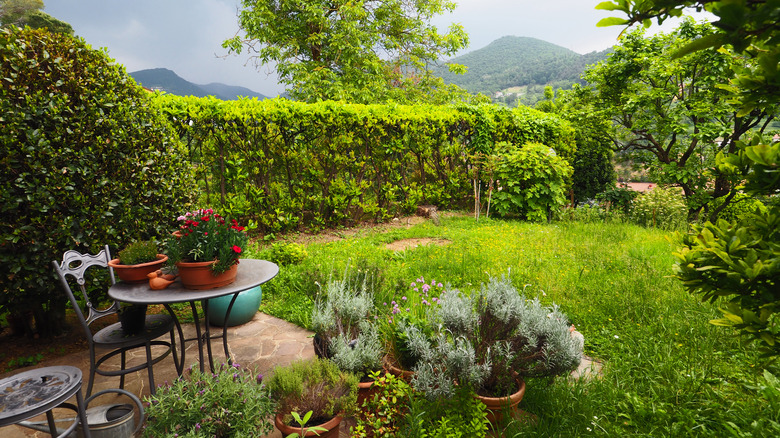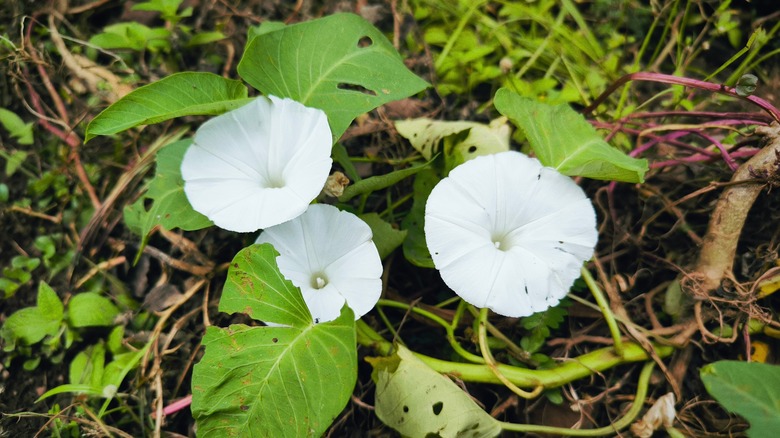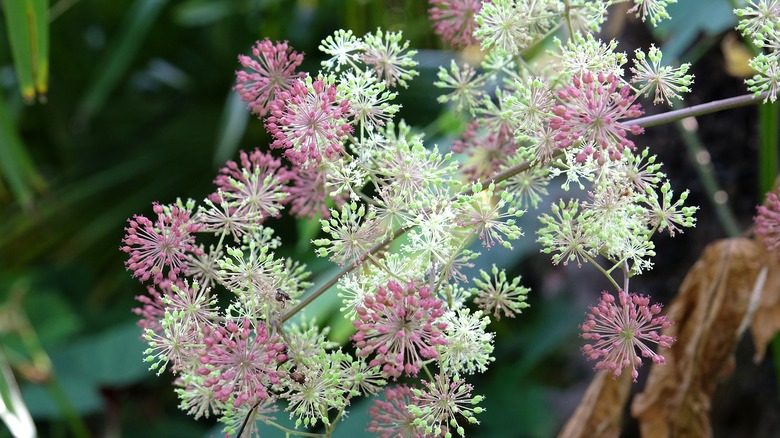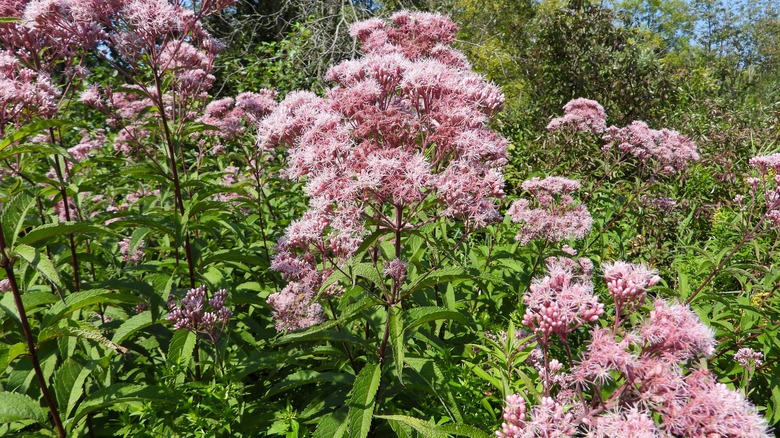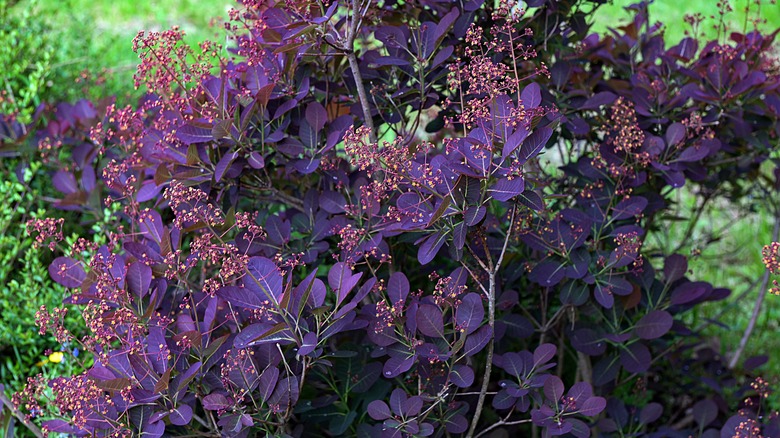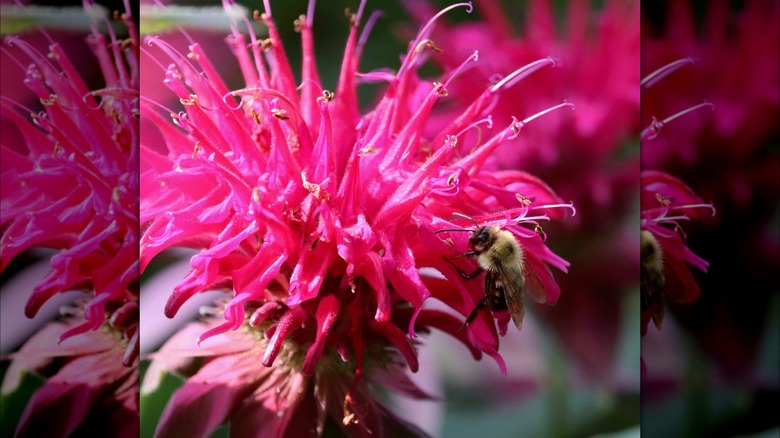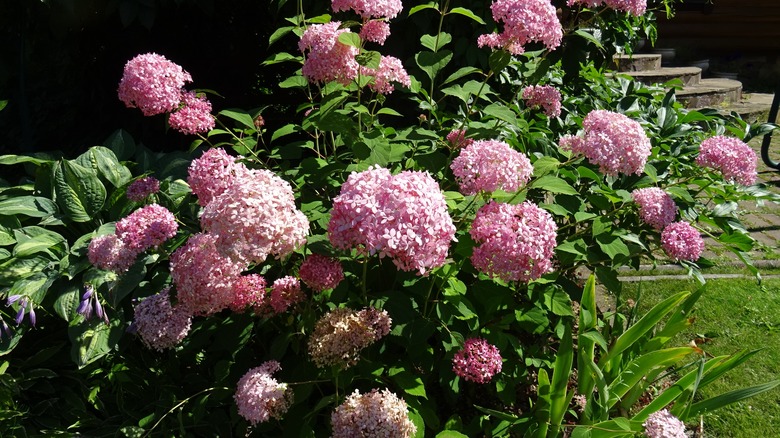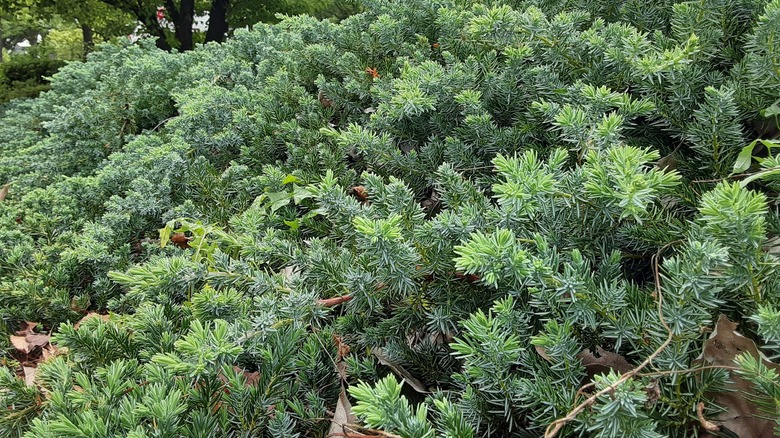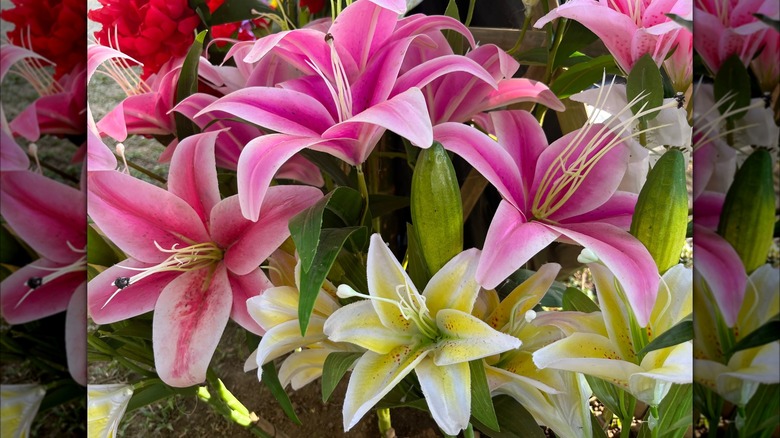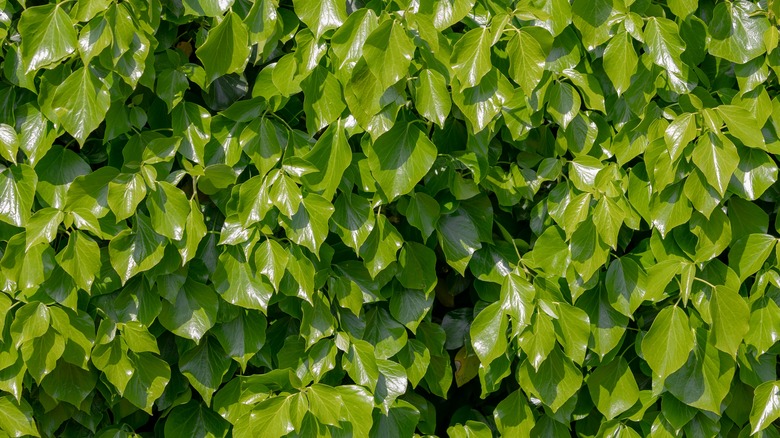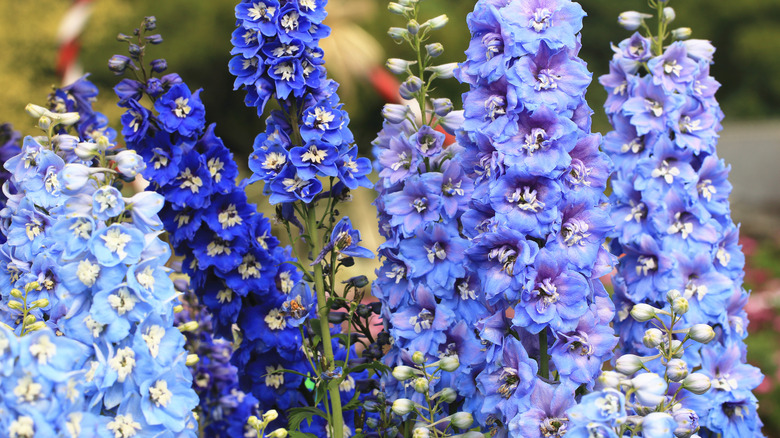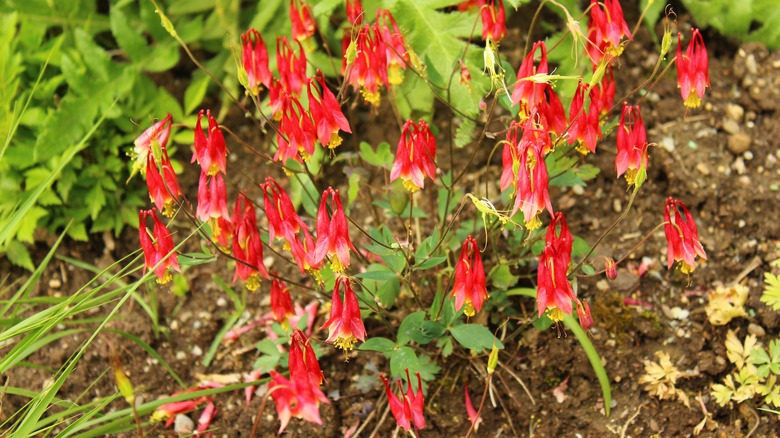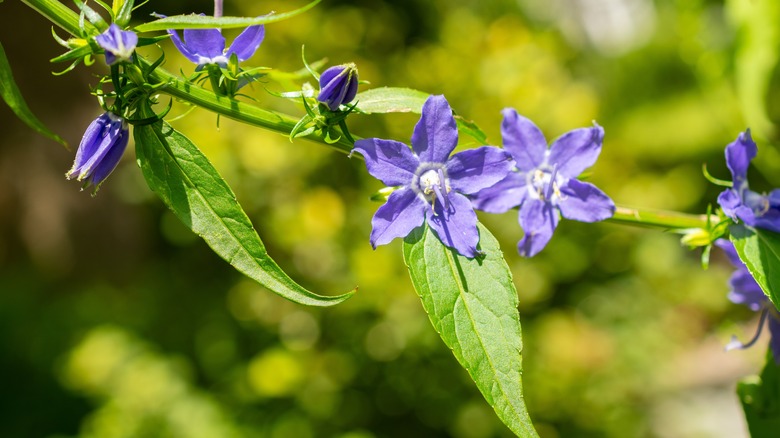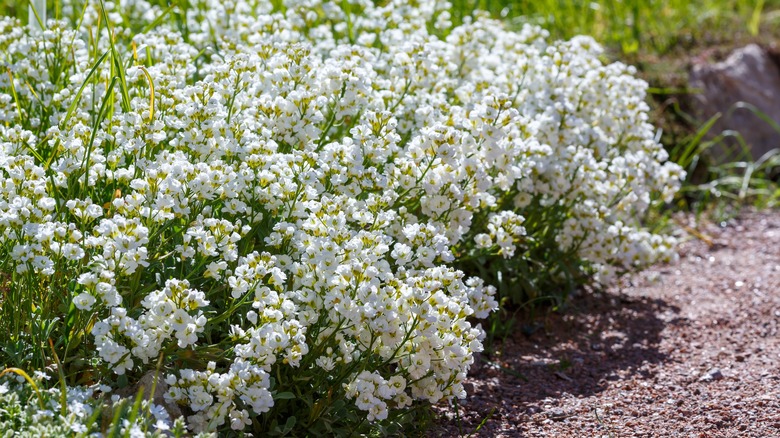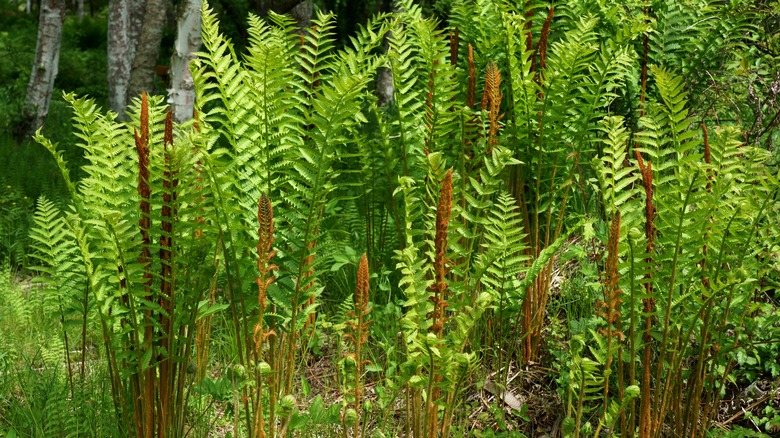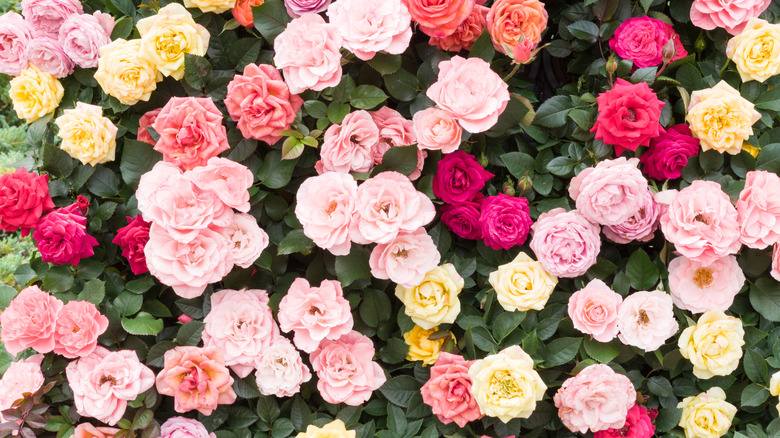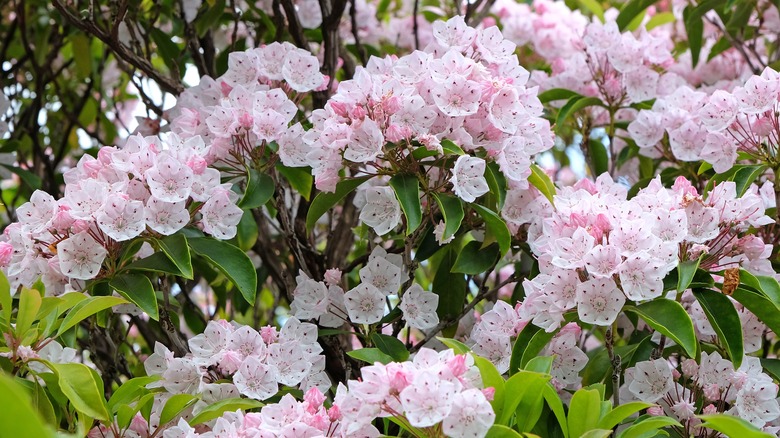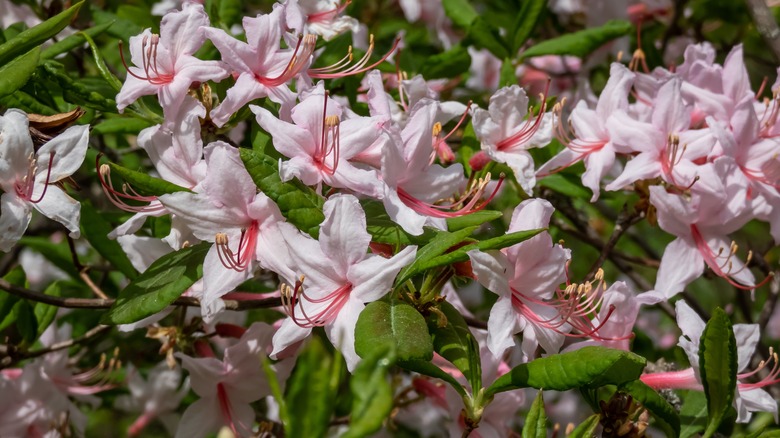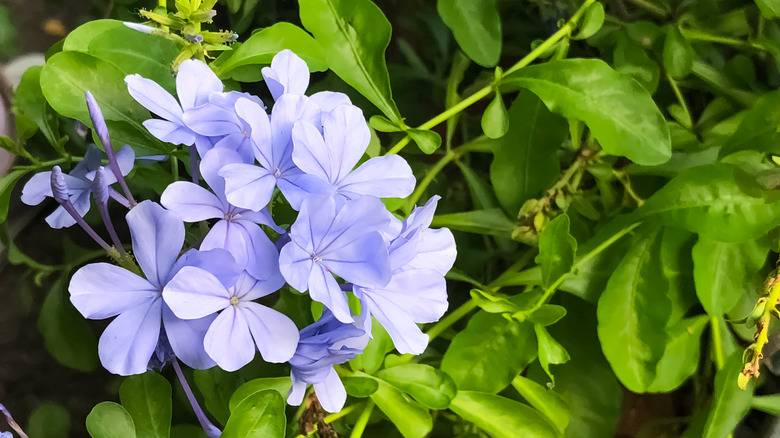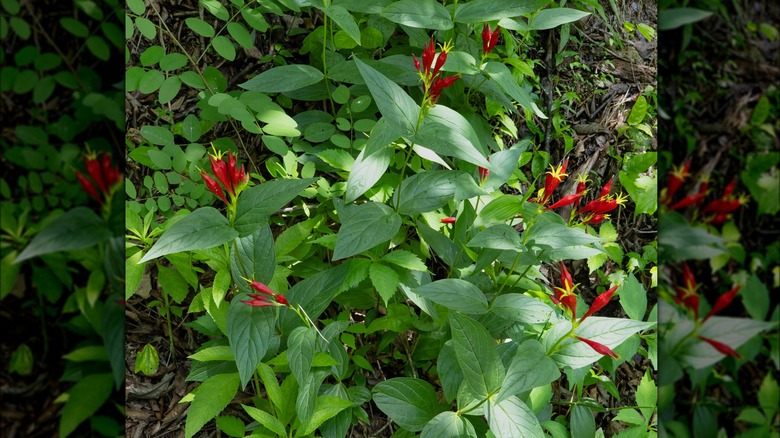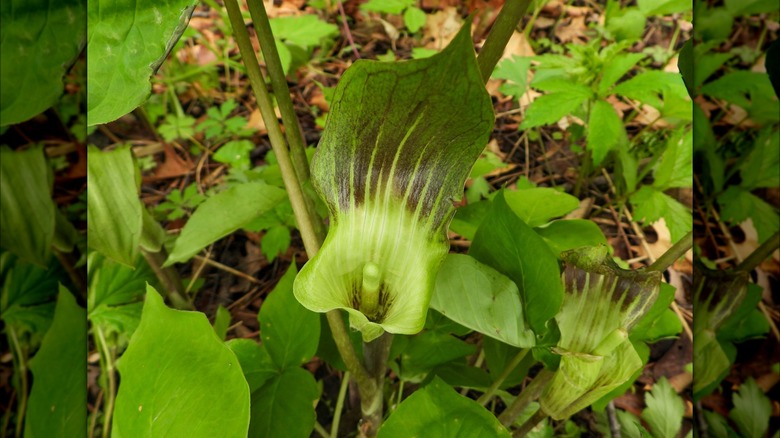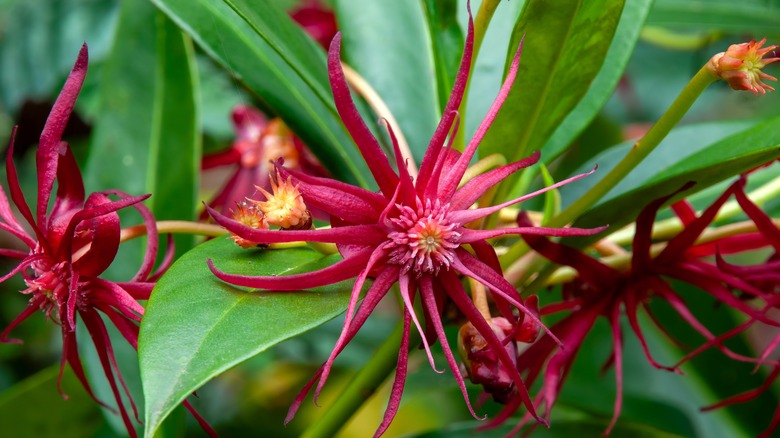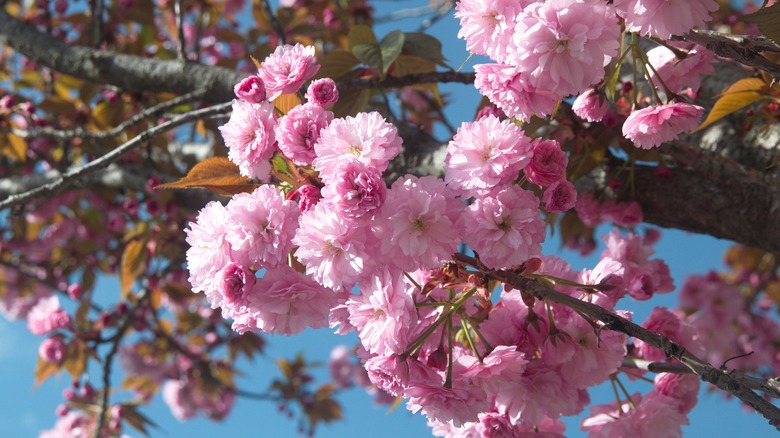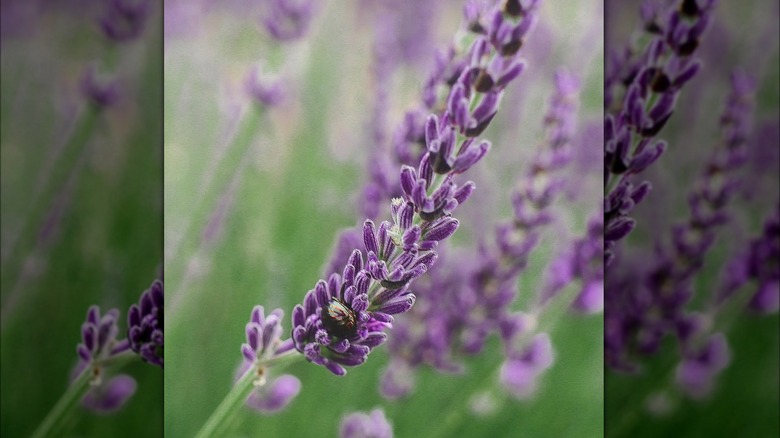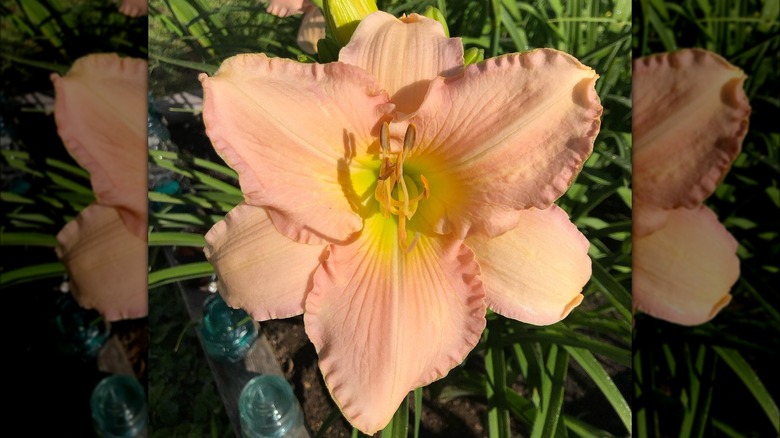24 Plants You Need In Your Yard To Create The Perfect Secret Garden Getaway
When Frances Hodgson Burnett crafted "The Secret Garden" in 1911, she likely had no inkling of the verdant world of imagination she would unleash upon generations — children and adults alike would itch to open their ivy-covered doors and get lost in an English garden, overflowing with flowers and bird songs. Yet, the idea of a "secret garden" has persisted, been reimagined, and personalized. Some weave a wildflower woodland for their book-reading escapades; others prepare isolated recreational spaces to host friends and family away from neighborly prying eyes. Ultimately, it all simmers down to your ingenuity.
While there are no hard-and-fast rules about what goes into a secret garden, the basic idea is to create a privacy screen of a sort with trees, flower-decked trellises, fences, lattices, stony walls, or hedges. Perennials and annuals raised on berms may also be used to cordon off the area or hide away your bistro tables and firepits. Next is to bring out its wildlife value. You could either attract more songbirds to your garden by planting beautiful shrubs and trees of various forms, stripes, shades, and textures or grow fragrant plants that will fill your garden with a variety of butterflies and hummingbirds. Another option is to choose plants on a theme to realize your musings, perhaps a night or a cottage garden (as Mary did). Ready to create a bespoke secret garden in your yard? Read on for eclectic planting options for your secret garden getaway.
Moonflowers
Moonflowers (Ipomoea alba), the 15-foot-high, annual (some places perennial) vines are what you need for your secret garden's entry gate, deck, or any trellis or arbor separating your space into private sections. Associated with intrigue and enlightenment, they lend a magical feel with their dusk-blooming, aromatic white flowers that will call your and nocturnal moths' attention, only to be gone by the next morning. They produce plenty of seeds, so allowing them to fully ripen on the vine during the fall ensures you have new plants to start next spring without another trip to the nursery.
Japanese spikenard 'Sun King'
Japanese Spikenard (Aralia cordata 'Sun King') is a superb addition to the shaded areas of your secret landscape. Deep shade will bring about a chartreuse green in their almost 3-foot-long leaves, but a few hours of sun exposure will offer a sprightly yellow glow. Summer-blooming white flowers and purple berries keep honeybees and birds happy. Hardy in USDA zones 4 through 8, 'Sun King' must be positioned in moist, loamy soils that don't get much wind. But if you ever get bored of the plant, dig out its roots and treat yourself to a Japanese delicacy.
Joe Pye weed
A victim of poor naming, Joe Pye weed (Eutrochium maculatum) is a gorgeous perennial that often gets shunted to the back of a secret garden because of its nearly 7-foot-high frame. But that won't stop the butterflies from fluttering about its rose-purple inflorescence, nor you from breathing in its vanilla aroma. This beautiful plant will thrive in clay soil in growth zones 4 through 9, provided it's given moderate to full sun exposure. Dry seedheads lend winter interest, but separate the plant in spring unless you're keen on the wildflower naturalizing itself beyond its confines.
Royal purple smoke tree
To keep autumn for the better part of your summer and erect a dramatic living fence or hedge at the same time, consider royal purple smoke tree (Cotinus coggygria 'Royal Purple'). Its purplish foliage gets topped by pink masses of seeds when the sun is available in plenty, and the tree turns a crimson red later in the fall. Barring the first year when consistent watering is essential for root establishment, it tolerates poor irrigation practices and drought stress, making it easy to maintain. However, you'll have to shear its limbs copiously for a bushier mound.
Bee balms
Reputed as flowers that hummingbirds absolutely love, bee balm (Monarda spp.) will make you fall in love with your secret garden when it's decked in jewel-toned lavender, pink, or white blooms. Breathing in its minty aroma as you crunch on its shed leaves has charm, too. Its straggly undersides can be off-putting, which can either be masked by planting similarly wild-looking flowers like roses and lavender upfront or be sacrificed by subjecting the bee-friendly plant to the Chelsea Chop pruning method. Give it full sun for the best blooms and to keep powdery mildew in check.
Smooth hydrangea
If you have laden your secret garden with meandering paths or paver blocks, consider highlighting them with smooth hydrangea's (Hydrangea arborescens) beauty. Hailing from the eastern U.S., these domed-shaped white flowers bloom on and off from spring through summer, luring in a legion of butterflies and pollinators while songbirds hop in when its brown fruits appear in the fall. They can grow about 5 feet tall and just as wide and may flop down after a heavy downpour. They're perfect for a woodland theme and prefer to remain in partial shade. Spring pruning is required for plant vigor.
Junipers
Take inspiration from "Jane and Whitney Harris Secret Garden," a demonstrative enigmatic space at Missouri Botanical Gardens, and hedge your secret garden with juniper trees. They'll instantly riddle your coastal garden with Mediterranean feels, putting that salt spray to good use. Or, if you've turned your backyard into a secret garden oasis by littering it with fairy fountains, junipers will serve as effective backdrops. The best part, though? They come in various forms, including ground covers (Juniperus conferta 'Blue Pacific') and shrubs (Juniperus chinensis 'Pfitzeriana Glauca'), befitting every occasion. Give them full sun and well-draining soil.
Lilies
For those meaning to get a semblance of the secret garden penned by Burnett, lilies (Lilium spp.) in their multi-colored, multi-formed glory are a splendid option. Though, unlike the book, you don't have to limit yourself to late-blooming ruby red or white varieties. Instead, elect for successive blooming, starting with double Asiatic lilies, followed by trumpet, oriental, and tiger lilies, whipping up color and textural contrasts. However, make sure their cultural conditions intersect and are dutifully met — most varieties require fertile, acidic soils and full-to-part sun. Avoid growing lilies if you enjoy daydreaming in the company of your cats.
Persian ivy
Remember the ivy-adorned walls and gateway from Burnett's book? Or, ivy's strait-laced ubiquity in English gardens? While you can't have English ivy anywhere in your landscape, given its invasive nature, you can still have your trellis or the ground carpeted with a non-invasive, shade-loving, evergreen vine: Persian ivy (Hedera colchica). It attracts a slew of bees and birds with its nectar-rich, greenish-white umbels and winter-persisting bluish-black berries, and it heartily suppresses weeds as a ground cover. The star of the show is its broad, heart-shaped, leathery foliage, measuring over 10 inches in length. It's hardy in zones 6 to 9.
Delphiniums
To imbue your secret garden in the bluest blue nature has to offer, plant delphiniums, though you'll find plenty of other varieties in shades of pink and lavender. Cold hardy up to zone 3, delphiniums fare the best in sunny, alkaline soils and are very popular amongst butterflies and hummingbirds. Alas, they're severely toxic, so if you've got furry pets or inquisitive toddlers crawling into your exclusive space without a moment's notice, avoid this plant altogether. Native plant enthusiasts will be spoiled for choices. For instance, tall larkspur (Delphinium exaltatum) is endemic in the north central U.S. region.
Eastern columbine
Indigenous to the North American continent, eastern columbine (Aquilegia canadensis) is another must-have in your secret garden, either as a specimen that prods visitors along the path or a woodland wildflower accompanying bee-, butterfly-, or hummingbird-friendly plants. Even when not in bloom, wild columbine is attractive with its three-lobed leaves that, with enough moisture, become yellow or (rarely) a glowing orangish-red. As a self-seeder, eastern columbine naturalizes itself in the landscape, though you can harvest its seeds from the garden and replant to control its sprawl. 'Little Lanterns' and 'Pink Lanterns' showcase blue-green foliage and pink blooms, respectively.
American bellflower
Another pick-me-up from the Secret Garden book, but adapted to eastern U.S. soil is the American bellflower (Campanula americana). Mesic, loamy soils, and moderately sunny sites will have the bellflowers blooming their stellate, white-throated, tiny blue flower heads off all summer long. This will naturally earn the rousing approval of hummingbirds, skippers, and bumblebees who devour their sweet nectar. The best part, though? These low-maintenance plants can be started with seeds and self-sow themselves, meaning they'll keep returning year after year of their own accord. Plant them in drifts for the highest impact.
Caucasian rockcress
If you have added stone walls to your secret garden or have effusively strewn it with large rocks, you might want to explore Caucasian rockcress (Arabis caucasica) to fill in the crevices or as a cascading, drought-resistant flowering perennial. Cold hardy in zones 4 through 7 but sensitive to the southern summer, the Mediterranean import delights myriad bees and butterflies with perfumed white (rarely rosy pink) blooms in the spring festooned over evergreen foliage. It is one of the best plants to grow in shallow soil but must be pruned for shape and containment.
Cinnamon fern
Use cinnamon fern (Osmundastrum cinnamomeum) to highlight your secret garden's water features, such as a pond, a stream, or a fountain, and watch warblers build their homes. Its showy, leathery, soft fronds punctuated by cinnamon spores can grow over 5 feet tall when given sufficient moisture and fertile, acidic soils, turning an eclectic yellow or burnished orange in autumn. Alternatively, cinnamon ferns may be grown as vase-like deciduous groundcovers in USDA zones 4 through 9 in deeply shaded areas, but be prepared for them to spread about slowly. Cinnamon ferns are disease-, pest-, and deer-resistant.
Roses
When it comes to beauty and fragrance, roses (Rosa spp.) are hard to beat. Plus, being diverse, they suitably fit different scenarios. For instance, thorny species work as hedges, while hybrid tea roses complement wind-swept wildflowers. Select pink rose varieties to make a blushing garden with an old-school English charm, such as 'the Alnwick Rose,' 'Anne Hathaway,' or 'Bishop's Castle.' Or lace your fences and walls with climbing roses like 'Zéphirine Drouhin.' Ensure their cultural and growth requirements match your site, given that they're already high maintenance with ceaseless demands for regular deadheading, pruning, and pest management.
Mountain laurel
Deck your woodland-themed secret garden with mountain laurel (Kalmia latifolia) for year-round, accented interest. This eastern U.S. native explodes in saucer-shaped, maroon-dotted, pink or white flowers in the spring, calling forth the attention of hummers and butterflies. Although its rhododendron-ish, evergreen foliage adds fall interest by aging into yellows, it's mostly prized for its role as a winter shelter — so you're sorted on the wildlife value front. Even better, laurels adjust to sub-optimal light conditions, courtesy of the rows of neighboring trees dappling your backyard. However, they're flammable and must be sited beyond your home's defensive zone.
Azaleas
Given their predilection for naturalization, azaleas and rhododendrons work beautifully in secret gardens, either as understory shrubbery for woodland trees or as beautiful specimens that entice hummingbirds and pollinators with their spring-appearing, multi-hued bell flowers. Evergreen, reblooming varieties like the 'Perfecto Mundo' ensure four-season interest upwards of zone 6. However, native plant aficionados can explore local, deciduous varieties like Pinxterbloom azalea (Rhododendron periclymenoides) that have little need for pruning and prefer dappled shade to keep themselves from burning under the sun's glare. Avoid heavy, clay soils at all costs, or work organic matter into them before planting.
Woodland phlox
Coming in hot in varying shades of blue, violet, pink, and white, woodland phlox (Phlox divaricate) is a shallow-rooted perennial that must be planted along the pathways leading inside your secret garden to truly appreciate its sweet fragrance. Alternatively, you can plant it ahead of spring-flowering plants like bellwort and bloodroot to conceal their dying foliage in woodland themes. Woodland phlox tolerates most soil conditions, from clay to dry, but favors partial shade over full sun conditions unless in upper ranges. Rabbits won't stop browsing its foliage, however, but that's to be expected of Burnett's concept.
Indian pink
Bloody red on the outside, oozing buttery yellows on the inside, Indian pink (Spigelia marilandica) or pinkroot is the native plant for a sustainable approach to attracting hummingbirds and songsters if you live in Illinois, Tennessee, or Kentucky. Growing over 2 feet tall, it naturalizes itself in moist, humus-rich soils and is a great barrier plant against fire hazards. Ample sun with irrigation to match will induce bushy growth, but if you want to keep it low maintenance, plop it in a shaded area. 'Little Redhead' cultivar offers profuse, butterfly- and hummer-attracting summer blooms.
Jack-in-the-pulpit
For a truly unique plant (or an excuse to discuss plant biology with your friends), mass plant Jack-in-the-pulpit (Arisaema triphyllum) in your secret garden — deep shade, herbivory, and wet soils are no bar. The 2-foot-tall wildflower sprouts spikes covered in purplish-green blooms ("spadix") that are eventually sheathed by purple or whitish-green banded hoods. Its rare design is because of the top male flowers and the bottom female ones. Yet, it doesn't self-pollinate; instead, it depends on flies to do the job, which can be a downside for some. Goths will love 'Black Jack' for its dark, glossy foliage.
Florida anise
Renowned as the plant that will flood your rain garden with abundance, Florida anise (Illicium floridanum) does a brilliant job as a specimen, accent, or hedge in secret gardens thanks to its over 6-foot tall physique, burgundy blooms, licorice-smelling glossy evergreen foliage, and out-and-out attraction to pollinators. Plonk it in a dappled or deeply shaded site, as its leaves don't take well to long exposures to direct sunlight. Acidic, organically rich soils are preferred in growth zones 7 to 10. Relatively pest-resistant, as insects despise the aroma wafting out its blooms, but poisonous to humans on accidental ingestion.
Japanese flowering cherry
If you're still reeling under cherry blossom memories from your Japan trip, slip in a Japanese flowering cherry (Prunus serrulata 'Kanzan,' previously ”Kwanzan') as a focal specimen in your Asian- or cottage-themed secret garden. Being grafted (mostly) and fruitless, it doesn't turn invasive, though this works conversely, too, limiting its utility to birds. But the double pink blooms are exceptionally enchanting, as is their yellowish-copper fall color. Plus, they make decent shade trees. However, if your area is woefully invaded by Japanese beetles, spider mites, and borers, avoid growing this plant as it's highly vulnerable to pests.
Provence French lavender
Hybridized from English and Portuguese lavender, Provence French lavender (Lavandula x intermedia 'Provence') is the herb for your secret garden when a strong fragrance is paramount (given its reputation in the perfumery industry). It produces ravishingly purple blooms during the summer (although they're best left for potpourris) atop silver-green leaves that are well-liked by butterflies and bees. More than six hours of direct sunlight, alkaline soils, and sandy texture are favored growth conditions, though it makes do with poor nutrient levels. It grows 3 feet wide and tall, but leave extra space to enjoy its curvaceous mound.
Daylily 'Secret Garden'
On the nose, if you will, daylilies (Hemerocallis) 'Secret Garden' might hold the key to glorifying your tacky side yard into an exclusive getaway. Keeping in line with their genus, the blooms don't outlast a day, but the gold-throated, mauve-haloed peach petals make for a glorious sight, and their absence post-midsummer is made up for by their evergreen foliage. Removing the spent blooms will lengthen the flowering season by inducing reblooming. However, don't bother saving the seeds, as they won't grow true to the parent. Cold hardy from zones 3 to 9, daylilies acclimate to most soils and require part-to-full sun.
